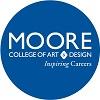The University of the Arts (UArts) was formed in 1876 by the merging of two century-old institutions: Philadelphia College of Art and Philadelphia College of the Performing Arts. In 1987, the school was granted university status, making it the largest institution of its kind in the nation. Today, UArts “is the only school in America that makes it possible to work and collaborate across traditional boundaries.”
UArts serves approximately 1,800 students enrolled in more than 40 programs at the University's Avenue of the Arts campus. Twenty-three minors are also available and open to all students. This means, aspiring graphic designers can take sculpting classes, creative writers can take classes in illustration, dancers can minor in ceramics, and industrial designers can study guitar.
Programs are offered through the Schools of Art, Dance, Design, Film, Music, and Theater. The College of Art, Media & Design houses the School of Design, which offers a BFA in Graphic Design and a BFA in Illustration with specialized graphic design courses.
The BFA in Illustration blends creative visual problem solving, digital experiences, drawing, figure modeling, illustration, painting, picture making, digital experiences, and graphic design, as well as self-discovery through mentor-student relationships, and history of pictorial image making. Course highlights include Anatomy & the Human Figure, Figurative Interpretation & Personal Voice, Illustration Markets and Promotion, Illustration with Digital Media, Motion-Based Illustration, New Media Illustration, Object & World Building, Printmaking, and the Illustration Thesis.
Students may also select one option from the following: School of Design Workshop, Illustration Workshop: Personal Viewpoint or the Design Internship.
Other program highlights include shared studio spaces, small class sizes, and training in industry-standard digital software such as Adobe Photoshop, Illustrator, InDesign and After Effects. Students also receive training in anatomy, integrating typography, experimenting with traditional painting methods, and developing narratives for a well-rounded experience across media.
Graduates of the BFA Illustration Program at UArts have gone on to create illustrations for ESPN, Fortune, Ralph Lauren, Random House, Rolling Stone, The New Yorker and New York Times, and many others.
The BFA in Graphic Design is a cross-disciplinary program that includes courses such as Design for Interaction, Design for Persuasive Visual Communication, Digital Design Lab, Drawing as Seeing and Meaning, Drawing as Thinking, Editorial Systems, and Image and Narrative. Students will also complete Portfolio and Brand Development, Real World Design, School of Design Workshop, and Senior Thesis I-II. A Design Internship is also part of the program and some positions are paid.
Interns have the opportunity to work at professional venues ranging from individual artist studios to large branding firms such as Anthropologie (Urban Outfitters), Cartoon Network, and Sterling Publishing (Barnes & Noble).
Graduates of the UArts Graphic Design Program are prepared for employment in fields ranging from branding and motion graphics to publication design. Students and alumni have worked for 20th Century Fox, Blizzard Entertainment, Disney, DreamWorks, ESPN, Facebook Hallmark, Harper-Collins, Hasbro, Houghton Mifflin Harcourt, Knopf, Marvel Comics, MTV, NASA, National Geographic, Newsweek, Nickelodeon, NPR, Oprah, PBS, Penguin Group Publishing, Random House, Simon & Schuster, The Wall Street Journal, Time Magazine, and Warner Brothers.












